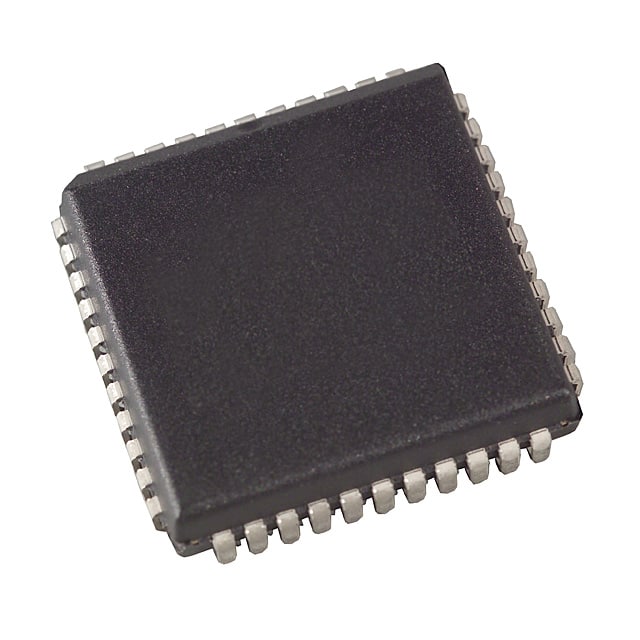Lihat spesifikasi untuk detail produk.

W79E201A16PL
Product Overview
- Category: Microcontroller
- Use: Embedded systems, electronic devices
- Characteristics: High-performance, low-power consumption, versatile
- Package: PLCC (Plastic Leaded Chip Carrier)
- Essence: Integrated circuit for controlling and managing electronic systems
- Packaging/Quantity: Individually packaged, quantity varies based on supplier
Specifications
- Manufacturer: Winbond Electronics Corporation
- Architecture: 8-bit
- Clock Speed: Up to 20 MHz
- Program Memory: 16 KB Flash
- Data Memory: 1 KB RAM
- I/O Pins: 32
- Operating Voltage: 2.4V - 5.5V
- Operating Temperature: -40°C to +85°C
Detailed Pin Configuration
The W79E201A16PL microcontroller has a total of 44 pins. The pin configuration is as follows:
- VDD: Power supply voltage
- VSS: Ground
- P0.0: General-purpose I/O pin
- P0.1: General-purpose I/O pin
- P0.2: General-purpose I/O pin
- P0.3: General-purpose I/O pin
- P0.4: General-purpose I/O pin
- P0.5: General-purpose I/O pin
- P0.6: General-purpose I/O pin
- P0.7: General-purpose I/O pin
- RST: Reset pin
- P1.0: General-purpose I/O pin
- P1.1: General-purpose I/O pin
- P1.2: General-purpose I/O pin
- P1.3: General-purpose I/O pin
- P1.4: General-purpose I/O pin
- P1.5: General-purpose I/O pin
- P1.6: General-purpose I/O pin
- P1.7: General-purpose I/O pin
- XTAL1: Crystal oscillator input
- XTAL2: Crystal oscillator output
- EA/VPP: External Access Enable / Programming Voltage Supply
- ALE/PROG: Address Latch Enable / Program Pulse
- PSEN: Program Store Enable
- P2.0: General-purpose I/O pin
- P2.1: General-purpose I/O pin
- P2.2: General-purpose I/O pin
- P2.3: General-purpose I/O pin
- P2.4: General-purpose I/O pin
- P2.5: General-purpose I/O pin
- P2.6: General-purpose I/O pin
- P2.7: General-purpose I/O pin
- P3.0: General-purpose I/O pin
- P3.1: General-purpose I/O pin
- P3.2: General-purpose I/O pin
- P3.3: General-purpose I/O pin
- P3.4: General-purpose I/O pin
- P3.5: General-purpose I/O pin
- P3.6: General-purpose I/O pin
- P3.7: General-purpose I/O pin
- RXD: Serial data input
- TXD: Serial data output
- INT0: External interrupt 0
- INT1: External interrupt 1
Functional Features
- High-performance 8-bit microcontroller suitable for various applications
- Low-power consumption for energy-efficient designs
- Versatile I/O capabilities for interfacing with external devices
- On-chip flash memory for program storage
- Built-in serial communication interface (UART)
- External interrupt support for event-driven programming
- Reset and power management features for system stability
Advantages and Disadvantages
Advantages: - High-performance and versatile microcontroller - Low-power consumption for energy efficiency - Ample program and data memory - Extensive I/O capabilities - Reliable and stable operation
Disadvantages: - Limited processing power compared to higher-bit microcontrollers - Limited memory capacity for complex applications - Lack of advanced peripherals and interfaces
Working Principles
The W79E201A16PL microcontroller operates based on the principles of digital logic and embedded systems. It executes instructions stored in its program memory, interacts with external devices through its I/O pins, and communicates with other components using its built-in UART. The clock speed determines the rate at which instructions are processed, while the voltage supply ensures proper functioning of the integrated circuit.
Detailed Application Field Plans
The W79E201A16
Sebutkan 10 pertanyaan dan jawaban umum terkait penerapan W79E201A16PL dalam solusi teknis
Sure! Here are 10 common questions and answers related to the application of W79E201A16PL in technical solutions:
Q: What is the W79E201A16PL microcontroller used for? A: The W79E201A16PL is a microcontroller commonly used in various technical solutions, such as industrial automation, consumer electronics, and embedded systems.
Q: What is the maximum clock frequency supported by the W79E201A16PL? A: The W79E201A16PL supports a maximum clock frequency of 16 MHz.
Q: How much program memory does the W79E201A16PL have? A: The W79E201A16PL has 20KB of program memory.
Q: Can I expand the program memory of the W79E201A16PL? A: No, the program memory of the W79E201A16PL cannot be expanded externally.
Q: How many I/O pins does the W79E201A16PL have? A: The W79E201A16PL has a total of 16 I/O pins.
Q: Does the W79E201A16PL support analog-to-digital conversion (ADC)? A: No, the W79E201A16PL does not have an integrated ADC.
Q: What communication interfaces are supported by the W79E201A16PL? A: The W79E201A16PL supports UART (Universal Asynchronous Receiver-Transmitter) for serial communication.
Q: Can I use the W79E201A16PL for real-time applications? A: Yes, the W79E201A16PL can be used for real-time applications as it has a built-in timer/counter.
Q: What is the operating voltage range of the W79E201A16PL? A: The W79E201A16PL operates within a voltage range of 2.7V to 5.5V.
Q: Is the W79E201A16PL programmable in C language? A: Yes, the W79E201A16PL can be programmed using C language with the appropriate development tools and compilers.
Please note that these answers are based on general information about the W79E201A16PL microcontroller. It's always recommended to refer to the datasheet and documentation provided by the manufacturer for accurate and detailed information.

